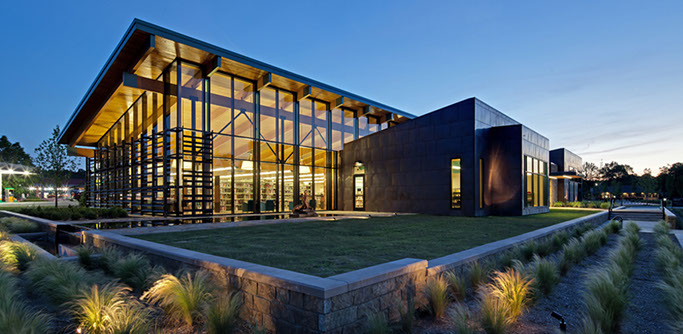ALLISON
PARTNERS
+
Your Partner in Creating Lasting Places
Five Often Overlooked Sustainable Features
April 20, 2015
Wednesday marks the 45th anniversary of Earth Day, and while it is a day dedicated to environmental protection, as architects, we consider this subject almost daily. We are now more aware than ever of the negative effects that the buildings in which we live, work, and spend a majority of our time in have on the ecosystem. The EPA states that buildings in the U.S. produce nearly 40% of the nation’s carbon dioxide emissions, a greater percentage than the automobiles (31%) that are so often associated with this toxic gas.1

Oley E. Rooker Library in Little Rock, Arkansas; awarded L.E.E.D. Silver in 2012, the first L.E.E.D. certification for the Central Arkansas Library System. Some of the building's sustainable features include a geothermal heating and cooling system that takes advantage of energy naturally found on-site; efficient landscaping practices, such as catch basins to clean and infiltrate water on-site; and specification of both regional and rapidly renewable materials.
Our clients often ask what can be done to reduce their building’s negative impact on the environment. Some strategies are widely known, such as installing LED lighting, specifying low VOC paints and materials, and using energy efficient appliances. However, there are some strategies that are considered less often. In no particular order, here are 5 sustainable building features that are often overlooked.
#1: Reducing the Need for Parking
Large paved areas, such as parking lots, have several negative impacts, including increasing storm water runoff (and often polluting that runoff), as well as increasing the temperature of the surrounding site through “heat-island effect”. Building in an area where occupants and visitors can arrive by walking, biking, or using public transit can decrease reliance on automobiles. Designing for the minimum parking to meet code and use allows for landscaped area to be maximized. When large parking lots cannot be avoided, alternative materials, such as open grid paving, can also be considered.
#2: Conserving Potable Water
According to the USGBC, five billion gallons of water are used every day just to flush toilets.2 This doesn’t even take into account the billions of gallons used for landscape irrigation. Some strategies to mitigate water usage, such as low flow plumbing fixtures, are commonly used; however another strategy is using captured rainwater for non-potable uses. Rainwater is captured and stored in a cistern and can be used to water plants and even to flush toilets.
#3: Installing Fans to Assist the Mechanical System
Living in Arkansas, we know it’s too humid to suggest relying only on passive cooling in lieu of air conditioning. However, installing fans and setting the thermostat one or two degrees higher can reduce the demand on the mechanical system while still allowing for a comfortable space. This practice is used often in residential design, but is rare in commercial building.
#4: Designing a Green Roof
Being honest, we know green roofs aren’t for every client and project; however, they have many benefits. Some of the benefits include reducing solar heat gain and thermal loss by providing extra insulation; mitigating rainwater runoff by absorbing some of the rainfall and reducing demand on storm sewers; and promoting biodiversity, helping to replace the habitat lost by the footprint of the building.

Hillside Auditorium at the University of Arkansas, Fayetteville; awarded L.E.E.D. Silver in 2014. The building’s vegetated roofs not only allow continuation of the natural topography across the site to maintain the prominence of the Greek Theater located nearby, but also assist the building in meeting the established energy use standards and the University’s sustainability efforts.
#5: Creating Green Company Policies
This is an area that we, as the architect, have no control over, but how occupants use the space can really affect the building’s energy use. A simple policy such as having employees shut down their computers and lights when leaving for the day can reduce the building’s internal heating load, in turn reducing demand on the mechanical system when the space is unoccupied. Other policies, such as implementing a recycling program or using green products to clean, can also have a positive impact on the environment.
1 “Buildings and Their Impact of the Environment: A Statistical Summary” (EPA, 2009), www.epa.gov/greenbuilding/pubs/gbstats.pdf.
2 LEED v2.2 New Construction and Major Renovation Reference Guide, 3rd Edition (USGBC, 2006), page 12.

Katie Bruhl, AIA, LEED AP
kkummer@allarch.com
Katie joined Allison Architects in 2008, assisting the firm as it began transitioning to using BIM (Building Information Modeling) software. Through her previous experiences, including a summer internship in Boston, Massachusetts, Katie has worked on a range of project types and has developed special interests in historic preservation, adaptive reuse, and sustainable building. As a L.E.E.D. Accredited Professional, Katie helps incorporate sustainable design strategies early in the design process.
Next Post
Return to Blog Home Page
Previous Post